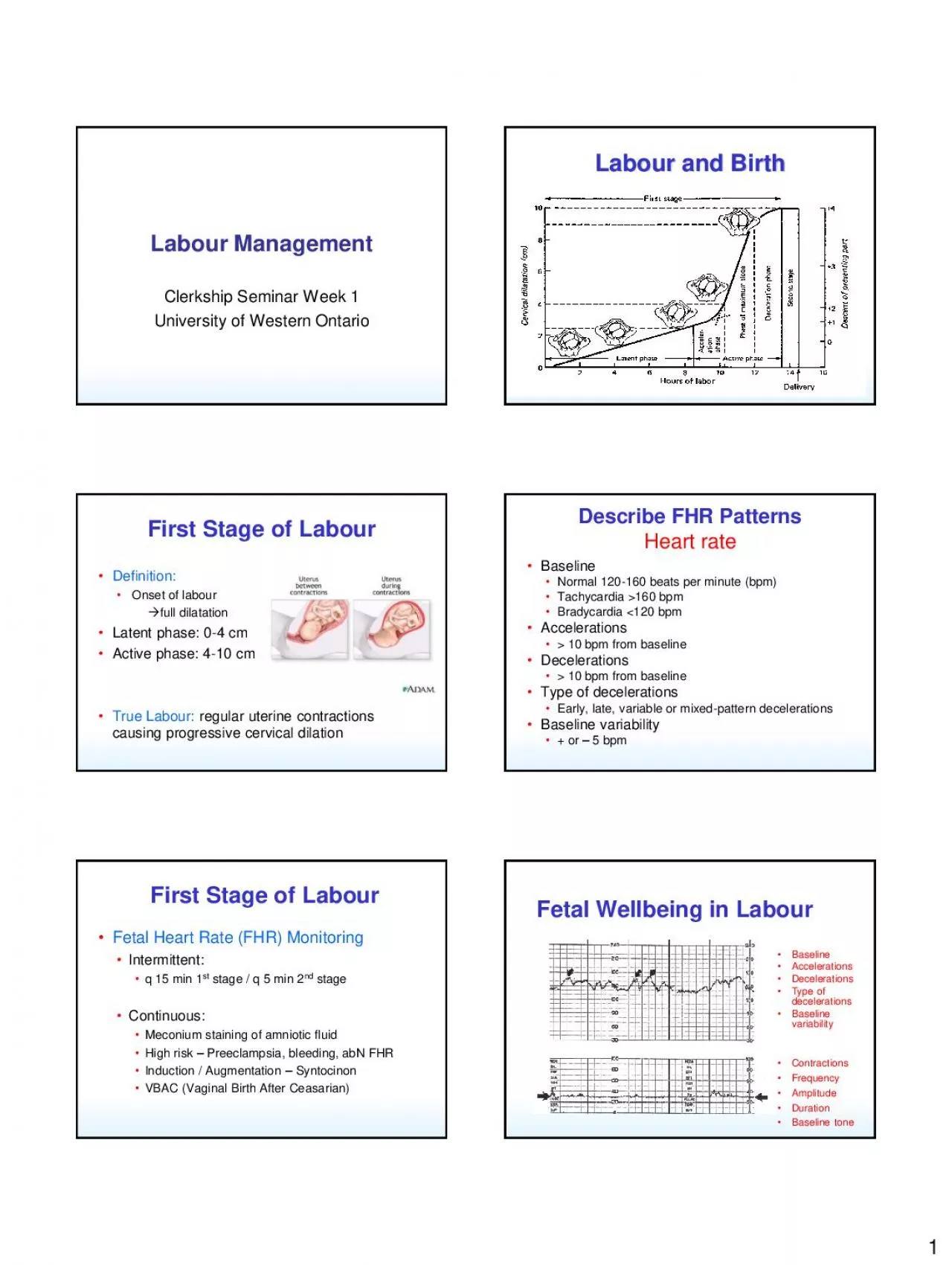

1 Clerkship Seminar Week 1 University of Western Ontario Labour and Birth First Stage of Labour Definition Onset of labour full dilatation Latent phase 0 4 cm Active phase 4 ID: 953869
Download Pdf The PPT/PDF document "Labour Management" is the property of its rightful owner. Permission is granted to download and print the materials on this web site for personal, non-commercial use only, and to display it on your personal computer provided you do not modify the materials and that you retain all copyright notices contained in the materials. By downloading content from our website, you accept the terms of this agreement.
1 Labour Management Clerkship Seminar Week 1 University of Western Ontario Labour and Birth First Stage of Labour • Definition: • Onset of labour full dilatation • Latent phase: 0 - 4 cm • Active phase: 4 - 10 cm • True Labour: regular uterine contractions causing progressive cervical dilation Describe FHR Patterns Heart rate • Baseline • Normal 120 - 160 beats per minute (bpm) • Tachycardia �160 bpm • Bradycardia 120 bpm • Accelerations • � 10 bpm from baseline • Decelerations • � 10 bpm from baseline • Type of decelerations • Early, late, variable or mixed - pattern decelerations • Baseline variability • + or – 5 bpm First Stage of Labour • Fetal Heart Rate (FHR) Monitoring •
Intermittent: • q 15 min 1 st stage / q 5 min 2 nd stage • Continuous: • Meconium staining of amniotic fluid • High risk – Preeclampsia, bleeding, abN FHR • Induction / Augmentation – Syntocinon • VBAC (Vaginal Birth After Ceasarian) Fetal Wellbeing in Labour • Baseline • Accelerations • Decelerations • Type of decelerations • Baseline variability • Contractions • Frequency • Amplitude • Duration • Baseline tone 2 Intrapartum Fetal Monitoring 1 Baseline Accelerations Decelerations Type of decelerations Baseline variability Contractions Frequency Amplitude Duration Baseline tone Intrapartum Fetal Monitoring 2 Intrapartum Fetal Monitoring 3 Intrapartum Fetal Monitoring 4 Intrapartum Fetal M
onitoring 5 Assessment of Uterine activity • Contractions • yes/no • Frequency of contractions • Optimally every 2 - 3 min • Amplitude • 40 - 60 mmHg • Duration • 60 - 90 seconds • Baseline tone • 15 mmHg 3 Progress in First Stage of Labour: Monitoring • Contractions : • by palpation – q 30 min early • Tocometer – in high risk or slow progress • Cervical change: • Q 2 hours in early labour • Sooner based on patient symptoms, FHR • Assess dilation, effacement, station Friedman Curve Friedman Curve (1967) • Normal curves of progress of labour • Not strict rules, but guideline • First stage • 6 - 18 hrs primip / active phase 1.2 cm/hr • 2 – 10 hrs multip / active phase 1.5 cm/hr Labour Dystocia
(Failure to progress) • Most common cited reason for C/S 1. Passage – Abnormal pelvis 2. Passenger – LGA fetus 3. Powers poor contraction pattern poor pushing Labour and Birth Second stage Second Stage of Labour • Definition : • Full dilatation delivery of fetus • Friedman: 30 min – 3 hrs primip 5 min – 30 min multips • Progress monitored by station • 0 = ischial spines • 1 - 5 cm (or thirds) of total distance 4 Fetal Position Occiput Lambdoid suture Posterior fontanelle Sagittal suture Anterior fontanelle Coronal suture Frontal s
uture Labour and Birth • Engagement • Descent • Flexion • Internal rotation Mechanism of Normal Labour (Cardinal movements) • Extension • External rotation • Expulsion Cardinal Movements Cardinal Movements Cardinal Movements Cardinal Movements 5 Vaginal Delivery Second Stage of Labour • Pelvic architecture issues: • Best outcomes with gynecoid & android • Cardinal movements may be inhibited by narrow or flat pelvis • Trial of labour is only true test of pelvic adequacy Labour and Birth Third stage Third Stage of Labour • Definition: • delivery of fetus expulsion of placenta • Timeline – 2 – 30 min • Active management – WHO / SOGC • Uterotonic agents (Syntocinon / Misoprostil ) • Gentle traction on c
ord • Fundal massage Third Stage of Labour • Signs of separation 1. New onset bright bleed 2. Lenghthening of cord 3. “balling up” of fundus • Uterine involution – oxytocin mediated • Inspection and repair of lacerations Labour and Birth Summary 6 Analgesia • Natural supported labour • Narcotics • Nitrous/Oxygen inhalation • Regional analgesia (Epidural) Induction • Indications: • Post dates • Preeclampsia • Diabetes Mellitus • Maternal disease (cardiac) • PROM / IUGR Induction • Methods • Syntocinon – synthetic oxytocin • Prostagalndins – Cervidil, Prostin gel, Misoprostol • ARM – artificial rupture of membranes, may be enough to initiate labour Augmentation • Failure to progress • Ox
ytocin infusion • Titrate to good contraction pattern and cervical change • Intrauterine pressure catheter (IUPC) Caesarian Section • Indications 1. Failure to progress 2. Non - reassuring FHR status 3. Previous caesarian section 4. Fetal malpresentation – breech, transverse • Responsible for 70% of sections Labour Dystocia (Failure to Progress) • Most common sited reason for C/S 1. Passage – Abnormal pelvis 2. Passenger – LGA fetus 3. Powers – poor contraction pattern - poor pushing 7 C/S Technique • Standard Uterine Incision – Lower uterine segment – Transverse – Low risk of rupture in subsequent labour (0.5%) • Vertical (Classical), or “T” Incision – High risk of rupture in subsequent labour (5%